
Predstavenie príkazov Ruby
1. Čo je Ruby?
Ruby je programovací jazyk s otvoreným zdrojom. Je interpretovaný a objektovo orientovaný. Ruby bol vytvorený Yukihiro Matsumoto. Ruby je pomenovaný po drahokame, a preto ho tvorca spájal ako klenot programovacích jazykov. tu budeme diskutovať o rôznych druhoch príkazov Ruby.
Dizajn Ruby zohľadňuje nasledujúce faktory - jednoduchosť, rozsiahlosť, úplnosť a prenosnosť. Ruby pracuje na väčšine platforiem založených na systéme UNIX. Veľká časť Ruby je postavená na Linuxe. Ruby tiež pracuje na bežných platformách ako Windows, DOS, Mac atď.
B asic Ruby Commands
1. Jednoduchý príkaz na tlačenie reťazca v Ruby
#!/usr/bin/ruby –w
puts “Hello, Ruby!”
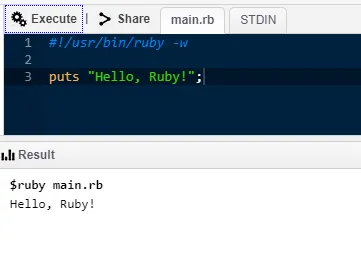
2. Jednoduchý príkaz na tlač viacerých riadkov pomocou EOF
#!/usr/bin/ruby –w
print < Multiple line string.
First wayEOF
print <<"EOF"; # same as above
Multiple line string.
Second way
EOF#!/usr/bin/ruby –w
print < Multiple line string.
First wayEOF
print <<"EOF"; # same as above
Multiple line string.
Second way
EOF
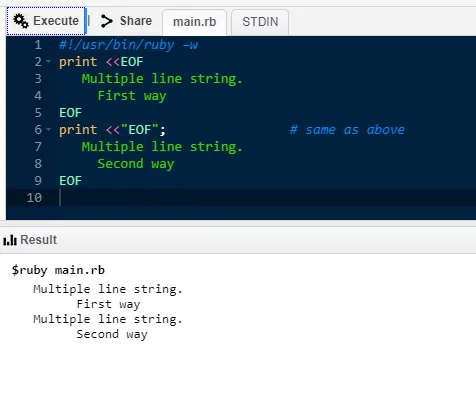
3. Jednoduchý príkaz na tlač viacerých riadkov reťazca pomocou vykonania príkazu
#!/usr/bin/ruby –w
print <<`EOC` # execute commands
echo First Statement
echo Second Statement
EOC

4. Jednoduchý príkaz na tlač viacerých riadkov stohovaním.
#!/usr/bin/ruby –w
print <<"a", <<"b" # you can stack them
I said foo.
a
I said bar.
b

5. Vyhlásenie Ruby BEGIN
#!/usr/bin/ruby
puts "This statement comes later"
BEGIN (
puts "This statement will be printed in the beginning"
)

6. Príkaz Ruby END
#!/usr/bin/ruby
puts "This is main body"
END (
puts "This block executes in the end"
)
BEGIN (
puts "This block executes in the beginning"
)

7. Komentár jedného riadku Ruby
#!/usr/bin/ruby
# This is a single line comment.
uts "This is not a comment" # This is again a single line
comment.
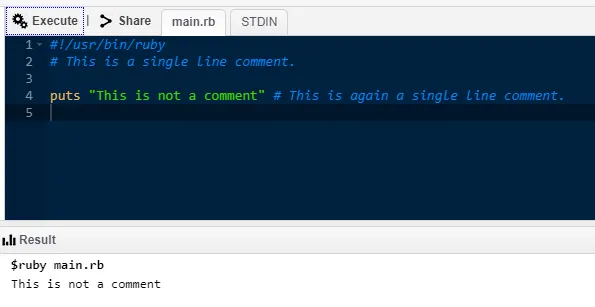
8. Ruby viac riadkový komentár
#!/usr/bin/ruby=begin
This is a multiple line comment.=end
puts "This is not a comment" # This is a single line comment.

9. Členská funkcia v triede Ruby. Vytvorenie objektu a volanie metódy.
#!/usr/bin/ruby
class Demo
def testmethod
puts "Hello World!"
end
end
# Now using above class to create objects
object = Demo.new
object.testmethod

10. Globálne premenné v Ruby
#!/usr/bin/ruby
$globalvariable=123
class FirstClass
def printglobal
puts "Global variable in FirstClass is #$globalvariable"
end
end
class SecondClass
def printglobal
puts "Global variable in SecondClass is #$globalvariable
end
end
class1obj = FirstClass.new
class1obj.printglobal
class2obj = SecondClass.new
class2obj.printglobal
Priebežné príkazy
1. AK… ELSE v Ruby
#!/usr/bin/ruby
x = 1
if x > 2
puts "x is greater than 2"
elsif x <= 2 and x!=0
puts "x is 1"
else
puts "I can't guess the number"
end

2. Prípad vo veci Ruby
<#!/usr/bin/ruby
$age = 17
case $age
when 0 .. 17
puts "Not eligible to vote"
when > 17
puts "Eligible to vote"
else
puts "incorrect age"
end
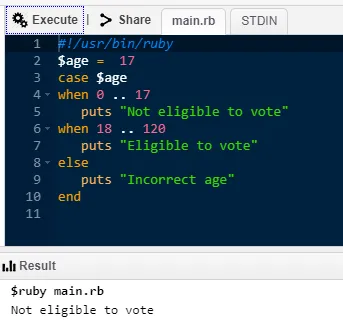
3. Slučky v Ruby
- 3.1. Zatiaľ čo slučka
#!/usr/bin/ruby
$i = 0
$num = 10
while $i <
$num do
puts("Inside the loop i = #$i" )
$i = $i + 1
end
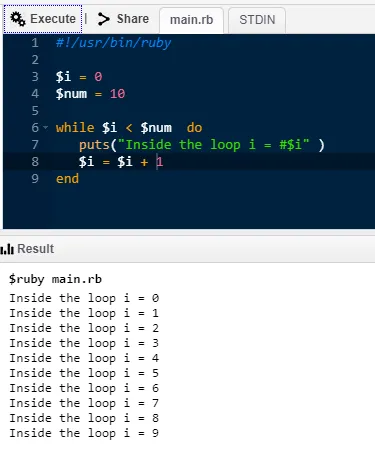
- 3.2. Až do slučky
#!/usr/bin/ruby
$i = 0
$num = 4
until $i > $num do
puts("Inside the loop i = #$i" )
$i = $i + 1;
end

- 3.3. Pre slučku
#!/usr/bin/ruby
for i in 0..9
puts "Local variable value is #(i)"
end
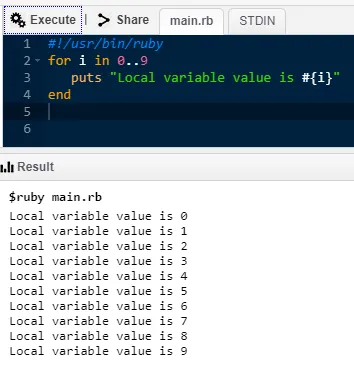
- 3.4. Vyhlásenie o prerušení
#!/usr/bin/ruby
for i in 0..5
if i > 3 then
break
end puts "Local variable is #(i)"
end

- 3.5. Ďalšie vyhlásenie
#!/usr/bin/ruby
for i in 0..10
if i < 6 then
next
end
puts "Local variable is #(i)"
end
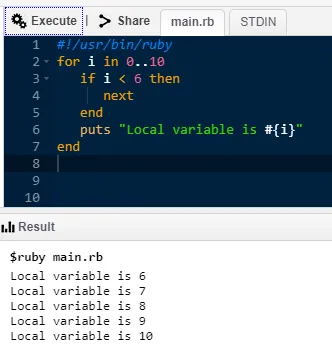
4. Syntax metódy v Ruby
#!/usr/bin/ruby
def test(a1 = "Noodles", a2 = "Pasta")
puts "The food is #(a1)"
puts "The food is #(a2)"
end
test "Burger", "Pizza"
test

5. Vyhlásenie o vrátení v Ruby
#!/usr/bin/ruby
def testreturn
a = 10
b = 20
c = 30
return a, b, c
endvar1 = testreturn
puts var1
6. Parametrizovaná metóda v Ruby
#!/usr/bin/ruby
def sample (*testparam)
puts "The number of parameters are #( testparam.length)"
for i in 0… testparam.length
puts "The parameters are #(testparam(i))"
end
end
sample "Hello", "123", "ABC", "Programming"
sample "World", "456", "Ruby"
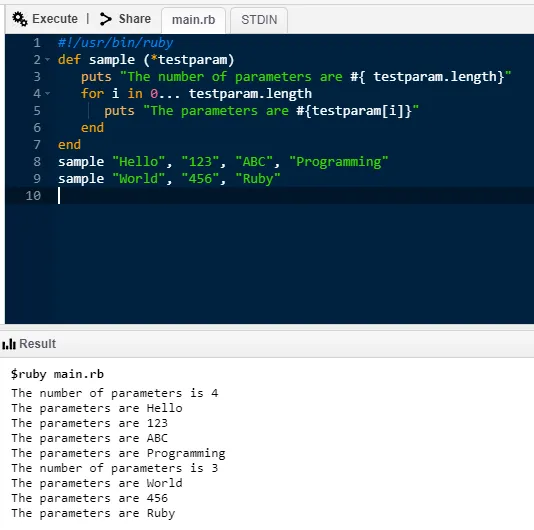
7. Implementačný blok pomocou výkazu výnosov
#!/usr/bin/ruby
def test
yield
end
test( puts "Hello world")

8. Bloky BEGIN a END v Ruby
#!/usr/bin/ruby
BEGIN ( # BEGIN block code
puts "BEGIN code block"
)
END (
# END block code
puts "END code block"
)
# MAIN block code
puts "MAIN code block"

9. Substitúcia reťazcových výrazov v Ruby
#!/usr/bin/ruby
a, b, c = 1, 2, 3
puts "The value of a is #( a )."
puts "The sum of b and c is #( b + c )."
puts "The average is #( (a + b + c)/3 )."

10. Tvorba poľa v Ruby
#!/usr/bin/ruby
names = Array.new(10)
puts names.size # returns 10
puts names.length # returns 10
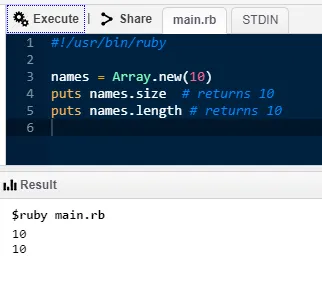
Pokročilé príkazy Ruby
1. Metódy getter a setter v Ruby
#!/usr/bin/ruby -w
# defining a class
class Box
# constructor method
def initialize(l, b, h)
@length, @width, @height = l, b, h
end
# accessor methods
def printLength
@length
end
def printBreadth
@breadth
end
def printHeight
@height
end
end
# create
an object
box = Box.new(10, 30, 40)
# use accessor methods
l = box.printLength()
b = box.printBreadth()
h = box.printHeight()
puts "Box Length : #(l)"
puts "Box Breadth : #(b)"
puts “Box Height : #(h)”

2. Písanie bežných skriptov rozhrania brány pomocou Ruby
#!/usr/bin/ruby "
require 'cgi'
cgi = CGI.new
puts cgi.header
puts "This is a test
3. Programovanie zásuviek pomocou Ruby
- 3.1. Jednoduchý príklad servera používajúceho Ruby
require 'socket' # Get sockets from stdlib
server = TCPServer.open(8090) # listen on port 8090
loop ( # Running the server infinitely
client = server.accept # Connecting client wait time
client.puts(Time.now.ctime) # send time to client
client.puts "Closing the connection!"
client.close # Client disconnect
)
- 3.2. Jednoduchý príklad klienta používajúceho Ruby
require 'socket' # Get socket from stdlib
hostname = 'localhost' # Set hostname
port = 8090 # Set portsock = TCPSocket.open(hostname, port)
while line = sock.gets # Read lines from the socket
puts line.chop # print with platform line terminator
end
sock.close # Socket closing
4. Príklad s viacerými vláknami v Ruby
#!/usr/bin/ruby
def function1
i = 0
while i<=2
puts "function1 at: #(Time.now)"
sleep(2) i = i+1
end
end
def function2
j = 0
while j<=2
puts "function2 at: #(Time.now)"
sleep(1)
j = j+1
end
end
puts "Started At #(Time.now)"
t1 = Thread.new(function1())
t2 = Thread.new(function2())
t1.join
t2.join
puts "End at #(Time.now)"
Tipy a triky na používanie príkazov Ruby
Keďže práca na akomkoľvek programovacom jazyku vyžaduje znalosti a ochotu upgradovať, tento prípad nie je výnimkou. Použitie základných príkazov a precvičenie a zvládnutie príkazov je kľúčom k ovládnutiu tohto krásneho jazyka.
Záver - Ruby príkazy
Príkaz Ruby je bezplatný a otvorený programovací jazyk; je flexibilný a bohatý na funkcie. Ako už názov napovedá, rubín je skutočne klenotníckym jazykom, ktorý má veľmi nízke vstupné náklady. Vďaka funkcii plug and play a ľahko čitateľnej syntaxi je veľmi užívateľsky prívetivý. Je to pokročilé skriptovacie zariadenie tiež zhŕňa jeho popularitu.
Odporúčané články
Toto bola príručka pre Ruby Commands. Tu sme diskutovali o základných príkazoch Ruby a niektorých príkazoch vopred Ruby. Viac informácií nájdete aj v nasledujúcom článku.
- Ako používať príkazy selénu?
- Najvyššie príkazy iskier
- Príkazy HBase
- Ako používať Tableau Commands?
- Programovanie zásuviek v Pythone